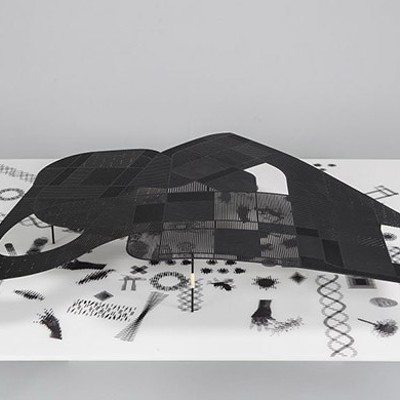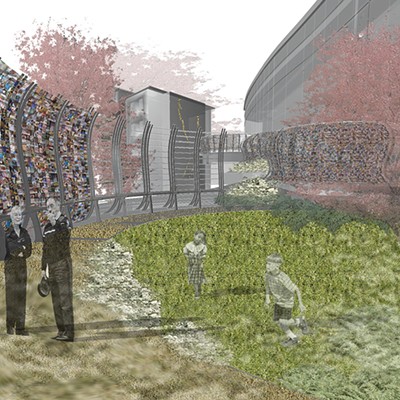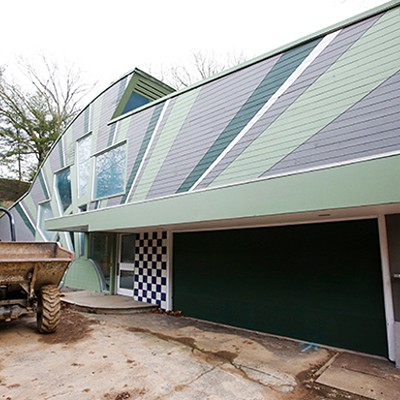Behind Closed Doors
An architecture student finds room for his lofty ambitions
We know that architects don't have a secret handshake, because so few of them could actually keep it a secret. But you can tell that some people are architects simply through their flamboyant details. They wear weird black shoes and shirts with unconventional collars buttoned at the very top. They write with frightfully expensive pens. Invariably, their first furniture purchase is an ostentatious and costly Mies van der Rohe "Barcelona" chair. Perhaps the true test in this contest of style and substance, however, is what someone does when they think no one is looking. In "Plywood Landscape: Overhead Underfoot," a project to redesign his Squirrel Hill living space, architect Julian Kinal demonstrates his talents by almost not demonstrating them at all.
Originally, hardly anyone was supposed to see this project. For the confines of Kinal's previously nondescript second-floor apartment, he convinced his landlord that nothing would happen to endanger his security deposit. He promised the neighbors that he would only work between noon and 8 p.m. on weekends. Surely nothing remarkable was going to take place. "Whatever I put up, I had to take down," Kinal confesses. But behind his courteous and unassuming demeanor, the recent graduate of Carnegie Mellon University (where I work as a part-time instructor) was actually concealing an irrepressible compulsion to create. Soon the sedate facade of his Tilbury Street duplex would be hiding an ambitious one-person testament to contemporary architecture.
When you walk up the narrow stairs to Kinal's apartment, a series of delicate, palm-size balsa wood models hang on the wall. These work as art objects in their own right, so you might not realize that they are study models for the space at the top. What Kinal explored at a delicate scale becomes exuberantly overwhelming at the top of the risers. The apartment looks as though it has been flooded, in some places ankle-high and elsewhere floor to ceiling, with a crashing wave of angular architecture in a consistent, saturated red. A shallow platform on the floor curves gradually upward toward the front windows into a funky upholstered living room that is surprisingly comfortable. Swooping walls, also unremittingly red, interrupt their flight to make niches for dining or sitting, while also unleashing a cantilevered canopy overhead -- another exercise in sculpting space as artfully as clay. Yet all the pieces are built about an inch-and-a-half away from the existing walls, making for easy removal as well as providing spooky lighting details. Illumination creeps upward from unseen sources.
Even stranger than the unburdened sculptural novelty of Kinal's apartment is its smooth functionality. As much as he seems to have created eye candy, Kinal actually began with a rigorous exercise of mapping the space to see how he and others moved through it. Only then did he start to design a structure that would recognize and enhance the established traffic patterns.
By the time this reaches print, Kinal's apartment will not simply be hidden -- it will be almost entirely gone. His lease is up, and Kinal is headed to London to study at the prestigious avant-garde Architectural Association, helped in no small part by a portfolio filled with photos and computer renderings of his living space. Take heart, though, because an elaborate display of these images remains in the Pittsburgh Platforms exhibit at the Heinz Architectural Center. Curator Raymund Ryan found Kinal when CMU identified him as promising young talent. The detailed display of Kinal's work is almost overburdened with forms and images, but it is worth careful scrutiny to understand this energetic project. Kinal is so full of creative energy that he has made a 3-D diagram of his comparative heating and electric bills as part of the display. Perhaps the best part is that the armature of this project's exhibit is actually a chunk of the apartment that Kinal hacksawed off to give to the exhibit.
Is he disappointed that all this time, effort and expense have gone into a project that was once obscure and is now all but destroyed? Kinal says no. Having a private effort turn into a piece in an exhibition was "beyond my wildest dreams," he says. Although he doesn't plan a similar project for himself in the near future, he does hope this project might lead to a paying client. But either way, he is not concerned about the money spent. "The whole thing cost about as much as one Barcelona chair."
Originally, hardly anyone was supposed to see this project. For the confines of Kinal's previously nondescript second-floor apartment, he convinced his landlord that nothing would happen to endanger his security deposit. He promised the neighbors that he would only work between noon and 8 p.m. on weekends. Surely nothing remarkable was going to take place. "Whatever I put up, I had to take down," Kinal confesses. But behind his courteous and unassuming demeanor, the recent graduate of Carnegie Mellon University (where I work as a part-time instructor) was actually concealing an irrepressible compulsion to create. Soon the sedate facade of his Tilbury Street duplex would be hiding an ambitious one-person testament to contemporary architecture.
When you walk up the narrow stairs to Kinal's apartment, a series of delicate, palm-size balsa wood models hang on the wall. These work as art objects in their own right, so you might not realize that they are study models for the space at the top. What Kinal explored at a delicate scale becomes exuberantly overwhelming at the top of the risers. The apartment looks as though it has been flooded, in some places ankle-high and elsewhere floor to ceiling, with a crashing wave of angular architecture in a consistent, saturated red. A shallow platform on the floor curves gradually upward toward the front windows into a funky upholstered living room that is surprisingly comfortable. Swooping walls, also unremittingly red, interrupt their flight to make niches for dining or sitting, while also unleashing a cantilevered canopy overhead -- another exercise in sculpting space as artfully as clay. Yet all the pieces are built about an inch-and-a-half away from the existing walls, making for easy removal as well as providing spooky lighting details. Illumination creeps upward from unseen sources.
Even stranger than the unburdened sculptural novelty of Kinal's apartment is its smooth functionality. As much as he seems to have created eye candy, Kinal actually began with a rigorous exercise of mapping the space to see how he and others moved through it. Only then did he start to design a structure that would recognize and enhance the established traffic patterns.
By the time this reaches print, Kinal's apartment will not simply be hidden -- it will be almost entirely gone. His lease is up, and Kinal is headed to London to study at the prestigious avant-garde Architectural Association, helped in no small part by a portfolio filled with photos and computer renderings of his living space. Take heart, though, because an elaborate display of these images remains in the Pittsburgh Platforms exhibit at the Heinz Architectural Center. Curator Raymund Ryan found Kinal when CMU identified him as promising young talent. The detailed display of Kinal's work is almost overburdened with forms and images, but it is worth careful scrutiny to understand this energetic project. Kinal is so full of creative energy that he has made a 3-D diagram of his comparative heating and electric bills as part of the display. Perhaps the best part is that the armature of this project's exhibit is actually a chunk of the apartment that Kinal hacksawed off to give to the exhibit.
Is he disappointed that all this time, effort and expense have gone into a project that was once obscure and is now all but destroyed? Kinal says no. Having a private effort turn into a piece in an exhibition was "beyond my wildest dreams," he says. Although he doesn't plan a similar project for himself in the near future, he does hope this project might lead to a paying client. But either way, he is not concerned about the money spent. "The whole thing cost about as much as one Barcelona chair."


















